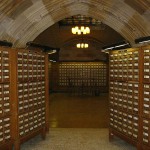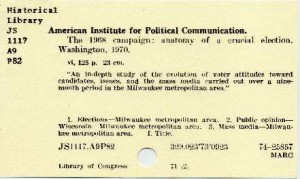Stupid Catalog
 I’ve got some bad news. If you have trouble using the UDM Library Catalog, it’s probably your fault. It might be typos in a search, or misuse of a search key, or even trying to use the catalog for purposes it’s not designed for.
I’ve got some bad news. If you have trouble using the UDM Library Catalog, it’s probably your fault. It might be typos in a search, or misuse of a search key, or even trying to use the catalog for purposes it’s not designed for.
That has to be true. After all, the only alternative is that it’s the catalog’s fault and since the catalog is only as good as the cataloger… I mean, I’ve been logging cattle for over 30 years now, so the chance that I would make a mistake is er, well…
Tell you what. Instead of assigning blame, let’s look briefly at what sort of information the library catalog is designed to deliver, as well as what it simply can’t do for you. This won’t eliminate typos, but it might prevent some frustration.
When searching for a book in the library catalog, you are not searching the text of the book as you would on Google. Instead, you are searching a brief description and summary meant to provide general information such as an author, title, or subject.
This description is based on standards originally devised for the legendary Card Catalog. Many libraries still had one in the 1980s, so your grandparents may remember them. Endless rows of cabinets with thousands of drawers each containing hundreds of cards, every card with very brief information about one book. Charming if you’re into nostalgia, but very limited as an information retrieval system. There is a limit to the amount of print that will fit into 15 square inches.
 Today’s technology allows the addition of much more descriptive information to the catalog, such as summaries and book contents. Instead of being limited to one 3” x 5” card for each book, we can use the equivalent of as many as we need. Instead of building six floors of card cabinets, we just tell IT to dump another server on the pile.
Today’s technology allows the addition of much more descriptive information to the catalog, such as summaries and book contents. Instead of being limited to one 3” x 5” card for each book, we can use the equivalent of as many as we need. Instead of building six floors of card cabinets, we just tell IT to dump another server on the pile.
However, the fact remains that the catalog indexes only a description of the book. This can be very helpful, but it’s still not an index for the entire text.
Finding information about journal articles is even more limited. The library catalog provides information about which issues of a particular journal are available from the library (either in print or electronically), but not about what you are really interested in: individual articles about a certain topic.
It is theoretically possible to put information about individual journal articles into the library catalog, but the amount of work and time required would be prohibitive. In addition it’s not necessary, since this information has already been assembled by publishers and indexers, and can be used though the many journal databases available through http://www.research.udmercy.edu . But that’s a different blog altogether.
 Though searching of both books and journal articles is not yet possible in the UDM Library Catalog, “one-stop” shopping may be coming in the future. DALNET (Detroit Area Library Network), a consortium which supports the UDM Library Catalog, is investigating a new generation of catalogs featuring “Discovery Systems”, which will allow simultaneous searching of the catalog and journal databases. This will be a welcome advance once it materializes. Even though the catalog comes under the provenance of what libraries call “Technical Services”, its first priority must always remain public service.
Though searching of both books and journal articles is not yet possible in the UDM Library Catalog, “one-stop” shopping may be coming in the future. DALNET (Detroit Area Library Network), a consortium which supports the UDM Library Catalog, is investigating a new generation of catalogs featuring “Discovery Systems”, which will allow simultaneous searching of the catalog and journal databases. This will be a welcome advance once it materializes. Even though the catalog comes under the provenance of what libraries call “Technical Services”, its first priority must always remain public service.
David Moody, Cataloging Librarian
